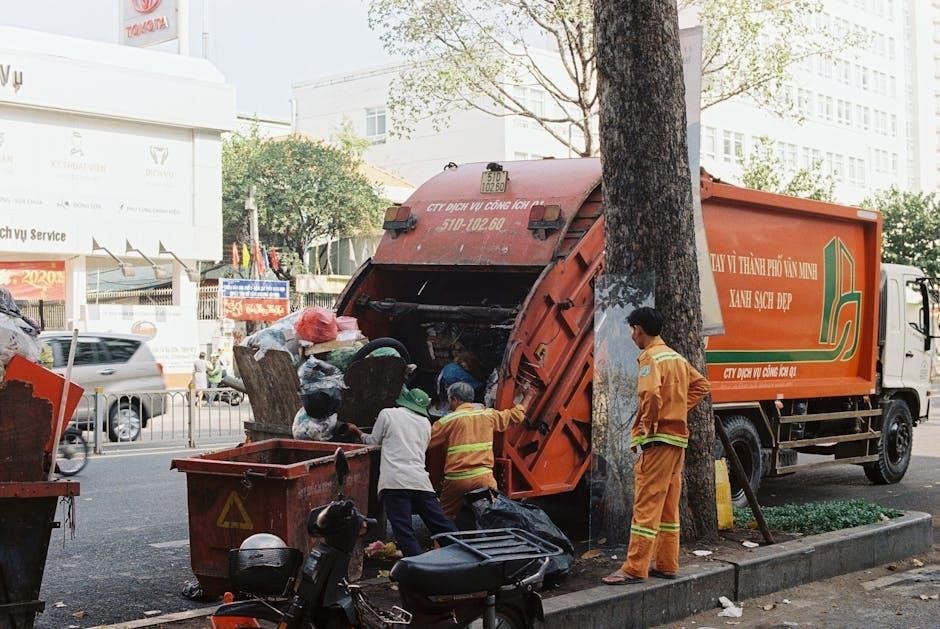A trash compactor manual provides essential guidance for installing, operating, and maintaining compactors, helping users optimize waste management efficiently while reducing environmental impact and ensuring safety.
What is a Trash Compactor?
A trash compactor is a device or system designed to compress waste materials, significantly reducing their volume. Available in manual and automatic models, compactors are used in both residential and commercial settings. They work by applying force to compact trash, making it more manageable and efficient for disposal. Manual compactors are portable, easy to use, and ideal for smaller spaces, while automatic ones offer higher compression power. They are versatile, handling various waste types, including household garbage and recyclables, making them a practical solution for waste management needs.
Why Use a Trash Compactor?
Using a trash compactor helps reduce waste volume, making disposal more efficient and cost-effective. It minimizes the need for frequent trash pickups, saving time and resources. Compactors are ideal for both residential and commercial settings, offering a practical solution to manage waste. By compressing trash, they reduce storage space requirements and lower waste transportation costs. Additionally, compactors contribute to environmental sustainability by decreasing landfill needs and promoting recycling. They are a versatile tool for anyone seeking to optimize waste management while maintaining cleanliness and efficiency.
Manual vs. Automatic Trash Compactors
Manual and automatic trash compactors offer distinct advantages. Manual compactors are cost-effective, portable, and require no electricity, making them ideal for small spaces or outdoor use. They rely on physical effort to compress waste, often with a handle or lever. Automatic compactors, while more expensive, provide convenience and higher compression power, suitable for heavy-duty use. They operate with the touch of a button, saving time and effort. Choosing between them depends on budget, space, and the volume of waste to be managed, ensuring an efficient solution for various needs.

Key Features of a Manual Trash Compactor
Durable construction, portability, and ease of use define manual trash compactors, offering efficient waste compression without electricity, ideal for small spaces and outdoor applications.
Construction and Durability
Manual trash compactors are built with durable materials like high-quality iron and steel alloys, ensuring long-lasting performance. Rust-proof coatings and sturdy frames enhance resistance to wear and tear. Compact designs allow for portability while maintaining strength. Heavy-duty construction supports consistent use, making them suitable for both indoor and outdoor applications. Durable handles and compression mechanisms ensure ease of operation without compromising reliability. These features make manual trash compactors a reliable choice for efficient waste management in various settings.
Ease of Use and Portability
Manual trash compactors are designed for simplicity and convenience, requiring minimal effort to operate. Their lightweight and compact designs make them easy to move and store, fitting seamlessly into various spaces. Many models feature ergonomic handles and straightforward mechanisms, allowing users to compress trash without bending or straining. Portability enhances versatility, enabling use in kitchens, offices, or outdoor settings. This ease of use ensures that anyone can efficiently manage waste, making manual compactors a practical solution for everyday needs.
Compression Power and Efficiency
Manual trash compactors deliver impressive compression power, significantly reducing waste volume. Constructed with durable materials and robust mechanisms, they efficiently compact trash, minimizing space and maximizing storage capacity. High-quality models often feature non-rust coatings and sturdy handles, ensuring consistent performance. By compressing waste tightly, these compactors help reduce the frequency of trash disposal, making them both cost-effective and eco-friendly. Their efficiency in handling various waste types, including paper and plastic, further enhances their practicality for household and commercial use.

Benefits of Using a Manual Trash Compactor
Manual trash compactors reduce waste volume, saving space and costs. They minimize landfill contributions, promote eco-friendly practices, and maintain cleanliness by controlling odors and pests effectively.
Space and Cost Efficiency
Manual trash compactors significantly reduce waste volume, minimizing the need for frequent bin replacements and collections. This saves space in both homes and offices, making them ideal for small areas. Their portability allows easy relocation, and the lightweight design ensures versatility. By compressing trash effectively, manual compactors lower disposal costs and reduce the number of waste bins needed. This efficiency makes them a cost-effective solution for managing waste, especially in urban settings where space is limited. Their practicality ensures long-term savings and optimized resource use.
Environmental Impact Reduction
Manual trash compactors significantly reduce environmental impact by minimizing waste volume, which lowers the need for frequent waste collections. By compressing trash, they decrease the amount of landfill space required, reducing methane emissions. Compact, efficient designs encourage recycling by separating materials effectively. This eco-friendly approach supports sustainable waste management, helping to conserve natural resources and decrease carbon footprints. Using manual compactors aligns with green practices, promoting a cleaner, healthier planet by reducing overall waste disposal needs and encouraging responsible waste handling.
Hygiene and Odor Control
Manual trash compactors enhance hygiene by tightly compressing waste, reducing odor emissions. The compact design prevents pests and bacteria from spreading, keeping surroundings cleaner. Durable materials resist rust and corrosion, ensuring long-term cleanliness. Regular use of compactors minimizes exposure to rotting waste, creating a healthier environment. Easy-to-clean surfaces and touchless operation further reduce contamination risks, making them ideal for maintaining a hygienic space in homes, kitchens, or offices while effectively controlling unpleasant smells.

How to Install a Manual Trash Compactor
Installation involves preparing tools, securing the compactor to a stable surface, and aligning it with the waste bin. Follow manual instructions for precise setup and safety.
Preparation and Tools Needed
Before installing a manual trash compactor, gather essential tools like a drill, mounting screws, and a level. Ensure a stable surface and clear the area. Wear safety gloves and eyewear. A wrench and measuring tape may also be necessary. Check the manual for specific requirements, such as a power source or additional hardware. Prepare the waste bin by ensuring it is clean and properly aligned. Optional materials like a rubber mat or sealant can prevent movement and odors. Proper preparation ensures a smooth and safe installation process.
Step-by-Step Installation Guide
- Unpack the compactor and inspect for damage.
- Choose a suitable location, ensuring a stable and level surface.
- Drill holes for mounting screws if necessary, following manual instructions.
- Secure the compactor using provided hardware, tightening firmly.
- Attach the handle or pedal, if applicable, ensuring proper alignment.
- Position the waste bin beneath the compactor according to specifications.
- Test the compactor by compressing a small amount of trash to ensure smooth operation.
Refer to the manual for specific instructions and adjustments.

Operating a Manual Trash Compactor
Fill the bin, use the handle to compress trash, and empty when full. Regular use reduces waste volume, making disposal more efficient and space-saving.
Starting the Compaction Process
Begin by ensuring the compactor is properly assembled and placed near your trash bin. Fill the compactor with waste, leaving space for effective compression. Hold the handle firmly and press down slowly, applying steady pressure to compact the trash. For optimal results, compress in intervals, allowing the waste to settle between presses. This method ensures maximum efficiency and reduces the volume of trash significantly, making disposal easier and more manageable;
Regular use helps maintain cleanliness and reduces odors, while the durable construction withstands frequent use.
Best Practices for Optimal Use
For optimal performance, clean the compactor regularly and store it in a dry, accessible location. Always compress waste in small batches to avoid overloading. Separate fragile items to prevent damage during compression.
- Use steady, consistent pressure to ensure even compaction.
- Avoid overfilling to maintain ease of use and efficiency.
- Refer to the manual for specific guidelines on compatible waste types.
Following these practices extends the lifespan of the compactor and enhances waste management effectiveness.

Maintenance and Troubleshooting
Regularly clean and lubricate moving parts to ensure smooth operation. Check for blockages and align components properly. For stuck parts, apply oil and gently maneuver. Refer to the manual for specific troubleshooting solutions to prevent damage and extend lifespan.
Regular Maintenance Tips
To ensure optimal performance, clean the compactor regularly using mild detergent and water. Lubricate moving parts periodically to reduce friction. Check for blockages in the compaction chamber and remove any debris. Align the compactor’s components properly to maintain balance. Refer to the manual for specific maintenance schedules. Regularly inspect and tighten loose bolts or screws. Prevent rust by drying the compactor after cleaning. Avoid overloading, as this can strain the mechanism. Store the compactor in a dry place to prevent moisture damage. Follow these tips to extend the lifespan and efficiency of your trash compactor.
Common Issues and Solutions
Common issues with manual trash compactors include rust, handle misalignment, or insufficient compression. To prevent rust, apply a rust-resistant coating and ensure the compactor is dry. If the handle loosens, tighten the bolts or replace worn parts. For poor compression, check alignment and ensure the compactor is on a level surface. If waste isn’t compacting evenly, clear blockages and ensure proper operation. Regular lubrication of moving parts can resolve sticking issues. Addressing these problems promptly ensures longevity and optimal performance of the compactor.

Safety Guidelines
Always wear protective gloves and eyewear when operating. Keep children and pets away. Avoid overloading the compactor, as this can cause malfunctions. Ensure proper handling and follow manual instructions to prevent accidents and maintain safety while compacting waste.
Operating Precautions
Always read the manual before use. Wear protective gloves and eyewear. Ensure the area is clear of obstacles. Never overload the compactor, as this can cause damage or injury. Handle the compactor with care, avoiding sudden movements. Do not force items that are too large or hard to compress. Keep children and pets away during operation. Regularly inspect the compactor for wear and tear. Ensure the handle is securely locked when not in use. Avoid compacting hazardous or prohibited materials as specified in the manual.
Child and Pet Safety
Ensure the trash compactor is out of reach of children and pets. Keep the device locked when not in use to prevent accidental activation. Never allow children to operate the compactor unsupervised. Store small parts or accessories safely to avoid choking hazards. Keep pets away from the compactor to prevent them from being injured. Regularly check for any loose components that could pose a risk. Teach children about the dangers of playing with the compactor and ensure they understand its proper use.

Environmental Impact
Trash compactors significantly reduce waste volume, lowering landfill use and carbon emissions. They promote recycling by compressing materials efficiently, contributing to a more sustainable environment and eco-friendly practices.
Waste Reduction and Recycling
Manual trash compactors significantly reduce waste volume by compressing materials, making recycling easier. They handle paper, plastic, and general waste efficiently, minimizing landfill trips. Compact waste reduces transportation needs, lowering carbon emissions. Effective compression allows for better segregation of recyclables, promoting eco-friendly practices. This approach supports sustainable waste management, aligning with environmental goals.
Eco-Friendly Benefits
Manual trash compactors offer significant eco-friendly benefits by reducing waste volume, lowering carbon emissions, and promoting efficient recycling. Their energy-efficient design minimizes environmental impact, as they require no electricity. By compressing waste, they reduce landfill contributions and extend the life of trash bins. This sustainable solution encourages responsible waste management, aligning with eco-conscious practices and supporting a greener planet.

User Reviews and Ratings
Users praise manual trash compactors for efficiency and durability, with models like the ikare compactor receiving high ratings for ease of use and space-saving design.
Popular Models and Feedback
Popular models like the ikare Manual Trash Compactor and Trash Tamp are highly rated for their efficiency and durability. The ikare model features a touchless design and a 35.4-inch handle, reducing back strain; Users praise its rustproof iron construction and ease of use. The Trash Tamp is renowned for reducing waste volume by up to 75%, making it a favorite for both residential and commercial use. Customers frequently highlight the portability and eco-friendly benefits of these compactors, with many awarding them high ratings for performance and value.

Customer Satisfaction and Recommendations
Customers report high satisfaction with manual trash compactors, praising their ease of use, durability, and effectiveness in reducing waste volume. Many recommend them for their ability to save space and lower disposal costs. Users highlight the eco-friendly benefits and how these compactors encourage better recycling habits. Feedback often emphasizes the value for money, with several models receiving top ratings for reliability and performance. Overall, manual trash compactors are widely endorsed for their practicality and contribution to sustainable living, making them a popular choice for households and businesses alike.
Final Thoughts on Manual Trash Compactors
Manual trash compactors offer a practical, efficient solution for waste management. They save space, reduce disposal costs, and promote eco-friendly practices with durable designs. A smart choice for sustainable living.
Manual trash compactors are a practical and eco-friendly solution for efficient waste management. They save space, reduce disposal costs, and minimize environmental impact by compressing waste effectively. With durable designs and ease of use, these compactors are ideal for both residential and commercial settings. They promote sustainability by reducing landfill contributions and encouraging recycling. Regular maintenance ensures longevity, making them a smart, long-term investment for anyone seeking to optimize their waste disposal process while supporting a greener lifestyle.
